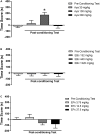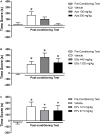Ayahuasca and Its DMT- and β-carbolines - Containing Ingredients Block the Expression of Ethanol-Induced Conditioned Place Preference in Mice: Role of the Treatment Environment
- PMID: 29896106
- PMCID: PMC5986901
- DOI: 10.3389/fphar.2018.00561
Ayahuasca and Its DMT- and β-carbolines - Containing Ingredients Block the Expression of Ethanol-Induced Conditioned Place Preference in Mice: Role of the Treatment Environment
Abstract
Ayahuasca is a hallucinogenic beverage produced from the decoction of Banisteriopsis caapi (Bc) and Psychotria viridis (Pv), β-carboline- and N,N-dimethyltryptamine(DMT)-containing plants, respectively. Accumulating evidence suggests that ayahuasca may have therapeutic effects on ethanol abuse. It is not known, however, whether its effects are dependent on the presence of DMT or if non-DMT-containing components would have therapeutic effects. The aim of the present study was to investigate the rewarding properties of ayahuasca (30, 100, and 300 mg/kg, orally), Bc (132, 440, and 1320 mg/kg, orally) and Pv (3.75, 12.5 and 37.5 mg/kg, i.p.) extracts and their effects on ethanol (1.8 g/kg, i.p.) reward using the conditioned place preference (CPP) paradigm in male mice. Animals were conditioned with ayahuasca, Bc or Pv extracts during 8 sessions. An intermediate, but not a high, dose of ayahuasca induced CPP in mice. Bc and Pv did not induce CPP. Subsequently, the effects of those extracts were tested on the development of ethanol-induced CPP. Ayahuasca, Bc or Pv were administered before ethanol injections during conditioning sessions. While Bc and Pv exerted no effects on ethanol-induced CPP, pretreatment with ayahuasca blocked the development of CPP to ethanol. Finally, the effects of a post-ethanol-conditioning treatment with ayahuasca, Bc or Pv on the expression of ethanol-induced CPP were tested. Animals were conditioned with ethanol, and subsequently treated with either ayahuasca, Bc or Pv in the CPP environment previously associated with saline or ethanol for 6 days. Animals were then reexposed to ethanol and ethanol-induced CPP was quantified on the following day. Treatment with all compounds in the ethanol-paired environment blocked the expression of ethanol-induced CPP. Administration of an intermediate, but not a high, dose of ayahuasca and Bc, as well as Pv administration, in the saline-paired compartment blocked the expression of ethanol-induced CPP. The present study sheds light into the components underlying the therapeutic effects of ayahuasca on ethanol abuse, indicating that ayahuasca and its plant components can decrease ethanol reward at doses that do not exert abuse liability. Importantly, the treatment environment seems to influence the therapeutic effects of ayahuasca and Bc, providing important insights into clinical practice.
Keywords: N; N-dimethyltryptamine; ayahuasca; conditioned place preference; ethanol; mice; reward; β-carboline alkaloids.
Figures






Similar articles
-
Ayahuasca blocks the reinstatement of methylphenidate-induced conditioned place preference in mice: behavioral and brain Fos expression evaluations.Psychopharmacology (Berl). 2020 Nov;237(11):3269-3281. doi: 10.1007/s00213-020-05609-6. Epub 2020 Jul 16. Psychopharmacology (Berl). 2020. PMID: 32676773
-
Ayahuasca blocks ethanol preference in an animal model of dependence and shows no acute toxicity.J Ethnopharmacol. 2022 Mar 1;285:114865. doi: 10.1016/j.jep.2021.114865. Epub 2021 Nov 22. J Ethnopharmacol. 2022. PMID: 34822961
-
Monoamine oxidase inhibitors in South American hallucinogenic plants: tryptamine and beta-carboline constituents of ayahuasca.J Ethnopharmacol. 1984 Apr;10(2):195-223. doi: 10.1016/0378-8741(84)90003-5. J Ethnopharmacol. 1984. PMID: 6587171
-
Ayahuasca for the treatment of alcohol use disorder.Int Rev Neurobiol. 2024;178:283-300. doi: 10.1016/bs.irn.2024.07.007. Epub 2024 Aug 10. Int Rev Neurobiol. 2024. PMID: 39523057 Review.
-
Ayahuasca: Psychological and Physiologic Effects, Pharmacology and Potential Uses in Addiction and Mental Illness.Curr Neuropharmacol. 2019;17(2):108-128. doi: 10.2174/1570159X16666180125095902. Curr Neuropharmacol. 2019. PMID: 29366418 Free PMC article. Review.
Cited by
-
Molecular Pathways of the Therapeutic Effects of Ayahuasca, a Botanical Psychedelic and Potential Rapid-Acting Antidepressant.Biomolecules. 2022 Nov 2;12(11):1618. doi: 10.3390/biom12111618. Biomolecules. 2022. PMID: 36358968 Free PMC article. Review.
-
Persisting Reductions in Cannabis, Opioid, and Stimulant Misuse After Naturalistic Psychedelic Use: An Online Survey.Front Psychiatry. 2020 Jan 22;10:955. doi: 10.3389/fpsyt.2019.00955. eCollection 2019. Front Psychiatry. 2020. PMID: 32038317 Free PMC article.
-
Modulation of neural activity and gene expression by arecoline.Front Integr Neurosci. 2025 Apr 9;19:1545260. doi: 10.3389/fnint.2025.1545260. eCollection 2025. Front Integr Neurosci. 2025. PMID: 40271198 Free PMC article.
-
Effects of ayahuasca and its alkaloids on substance use disorders: an updated (2016-2020) systematic review of preclinical and human studies.Eur Arch Psychiatry Clin Neurosci. 2022 Jun;272(4):541-556. doi: 10.1007/s00406-021-01267-7. Epub 2021 Apr 29. Eur Arch Psychiatry Clin Neurosci. 2022. PMID: 33914164
-
Ayahuasca blocks the reinstatement of methylphenidate-induced conditioned place preference in mice: behavioral and brain Fos expression evaluations.Psychopharmacology (Berl). 2020 Nov;237(11):3269-3281. doi: 10.1007/s00213-020-05609-6. Epub 2020 Jul 16. Psychopharmacology (Berl). 2020. PMID: 32676773
References
-
- Berro L. F., Perez Diaz M., Maltbie E., Howell L. L. (2017). Effects of the serotonin 2C receptor agonist WAY163909 on the abuse-related effects and mesolimbic dopamine neurochemistry induced by abused stimulants in rhesus monkeys. Psychopharmacology 234 2607–2617. 10.1007/s00213-017-4653-2 - DOI - PMC - PubMed
LinkOut - more resources
Full Text Sources
Other Literature Sources

